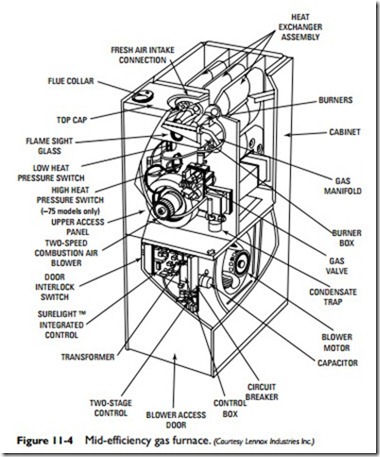Standing-Pilot Gas Furnaces
The majority of residential gas furnaces in use today are still the conventional standing-pilot types, although they are gradually being replaced by the more efficient mid-efficiency and high- efficiency furnaces (Figures 11-2 and 11-3).
A conventional standing-pilot gas furnace consists of a naturally aspirating gas burner, draft hood, a solenoid-operated main gas valve, a continuously operating pilot light, a thermocouple safety device, a 24-volt AC transformer, a heat exchanger, a blower and
motor assembly, and one or more air filters. The furnace is vented through a flue connection to a chimney.
The main gas valve used on a conventional standing-pilot gas fur- nace has a valve knob with a pilot position for lighting the pilot, and both a pilot tube and a thermocouple connection. A transformer provides 24-volt AC power to operate the main gas valve. When the pilot light is lit, the thermocouple sends an electrical current to hold the pilot valve open. If the pilot goes out, the thermocouple closes the valve.
Some standing-pilot gas furnaces use a millivolt generator instead of a 24-volt transformer to open the main gas valve. The main gas valve in these furnaces is specifically designed for use with the millivolt generator.
The energy efficiency of conventional gas furnaces has been improved by equipping them with a direct-drive blower and motor. Adding the direct-drive blower and motor creates a dual-capacity, variable-speed furnace that can match the heat output and circulating fan speed of the furnace to the actual heating requirements of the structure. The furnace is able to maintain the desired temperature comfort levels while, at the same time, saving energy and reducing energy costs.
Mid-Efficiency Gas Furnaces
Mid-efficiency gas furnaces are equipped with a naturally aspirating gas burner and a pilot light, but the pilot does not run continuously (Figure 11-4). The pilot is shut off when the furnace is idle (that is, when the thermostat is not calling for heat).
These furnaces have a more efficiently designed heat exchanger than the one found in conventional furnaces. The heat exchanger provides greater resistance to the flow of the combustion gases up through the flue and chimney. This allows the slowed gases to cool and condense. The heat normally trapped in these gases can be extracted from the condensate instead of being lost up the chimney. There is no draft hood as in a conventional standing-pilot gas furnace. It is replaced by a small fan in the flue pipe. The induced draft produced by the fan overcomes the cooler (heavier) exhaust gases and the resistance created by the more efficient heat exchanger. Furnaces equipped with these fans are sometimes called induced-draft furnaces. Other components (automatic controls, blower and blower motor assembly, venting, and so on) are the same as those found in a conventional standing-pilot furnace. Mid- efficiency gas furnaces are approximately 20 percent more energy efficient than a conventional gas furnace. The AFUE ratings are in the 78 to 82 percent range.
Note
Mid-efficiency furnaces with AFUE ratings higher than 85 percent often experience condensation problems in the furnace and the exhaust venting.
Some manufacturers of mid-efficiency furnaces install a motorized damper in the exhaust flue pipe. The damper automatically closes when the furnace is idle to prevent heat from escaping up the chimney.
